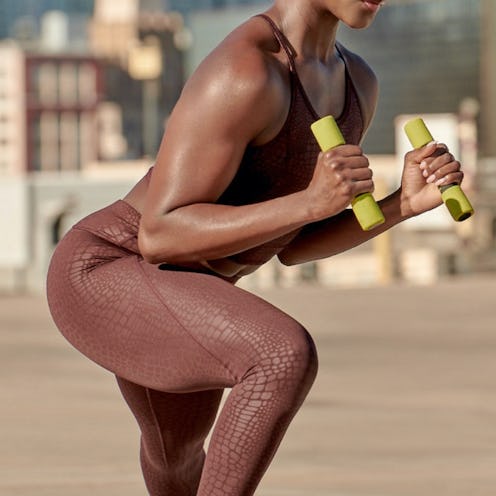(Fitness)
The Workouts Women Over 50 Should Implement ASAP
Fact: Cardio is not king.

In your 20s and 30s a great workout typically consisted of some sort of cardio session, 60 minutes of heart-pumping movement on an elliptical or tread mill machine or in a fancy HIIT studio. You likely entered and exited these exercise sessions without much thought — just checking it off the list of “healthy” things to do. At these stages, results from these no-brainer workouts were also easy to clock, with tone, strength, and increased energy coming fairly easy because, well, youth. Despite all the information out there about how bodies change through the decades, it still comes as a bit of a shock to the system when it begins to happen to you. Suddenly, your limbs seem to ache a bit when you wake up, you tire out much quicker than before, and maybe your weight is beginning to plateau despite your ongoing fitness efforts. The truth is, like your skin care routine, your approach to working out should change in your 50s to better cater to the evolving needs of your body.
All that to say, fitness doesn’t stop being important as you get older. In fact, it becomes more crucial than ever, especially as you enter menopause. According to research, regular exercise can reduce the metabolic risks associated with declining estrogen and offset the decline of bone mineral density and prevent osteoporosis. It can also help combat common symptoms of menopause like hot flashes, back pain, mood decline, and stress.
But it’s important to ensure you’re incorporating the right exercises and types of movement to harness these benefits. So that “cardio-first” mentality that served you well in your 20s will simply not cut it in your 50s. Actor Jennifer Aniston spoke of her own fitness journey recently with TZR, explaining that she “used to come from the philosophy of ‘cardio, cardio, cardio,’” but as she got older, she learned that “strength training not only helps maintain your muscle, it helps with avoiding osteoporosis in the future. Our bones have to stay strong because as we get older we fall over, [and] we can’t get up. And then you break a hip or you break a shoulder and that can lead to all sorts of stuff.”
Wise words to live by. Ahead, see the types of workouts you should be incorporating as you hit your 50s ... and beyond.
Strength Training
Women begin to lose muscle starting as early as 30, so workouts centered around strength and resistance training are crucial. While many women avoid weight lifting due to the stigma around “bulking up,” fitness trainers and experts will advise you to not only embrace the technique, but to prioritize it.
"Women over 50 years old should not feel afraid to engage in weightlifting and high intensity training, as these modalities of fitness have proven to help mitigate the aging process, improve bone health and cardiovascular function, and much more,” says Melanie Leguizamon, a professional personal trainer at Fitness Together Brentwood. “If you are just starting out, I’d recommend working with a personal trainer to ensure proper form and program development to get the most out of your workout. It is also important to not do too much too soon, as well as do an exercise routine you like and can be consistent with. No need to use very heavy weights, but definitely use some form of resistance to work upper and lower body.”
Strength training also helps improve metabolic rate. To start, Andrew White, personal trainer and co-founder of Garage Gym Pro recommends dumbbell squats to “help maintain leg and core strength.” And if weights aren’t readily accessible, he says wall push-ups are a great alternative to build “upper body strength without the strain of traditional push-ups.” Resistance band workouts are also solid options for those with an aversion to weights.
Aquatic Therapy
While perhaps a more surprising suggestion, aquatic exercises are ideal as you get older as they offer resistance training, muscle toning, and cardiovascular exercise with low-impact movement that isn’t hard on or damaging to the body.
“Aquatic therapy (aqua jogging, water aerobics, or walking in a pool) involves using water resistance to strengthen muscles and reduce strain on joints,” says Lilly Jackson, rehabilitator and fitness coach for health app Lasta.
Pilates Or Yoga
Core strength is critical to daily activity and injury prevention, especially as you hit your 50s. Annie Landry, founder of fitness program Create Movement recommends Pilates as it “helps you strengthen and lengthen your muscles with a low-impact workout. You can take a mat Pilates class or challenge yourself with a reformer class.”
Jackson seconds this notion, offering yoga poses like planks, bridges, and leg raises as being helpful for stability and back health. If you’re on the yoga track, White recommends adding tree and warrior poses to your list of daily moves to improve balance and leg strength.
Low-Intensity Cardio
While not as crucial as strength-training, cardio workouts are still important in your 50s. “Peri-menopausal and menopausal women often worry about weight gain,” says Landry. “It's still a good idea to complete cardiovascular exercise for overall health, but it's not necessary to complete high-impact or high-intensity workouts such as running unless that is something that you enjoy.” The fitness pro recommends walking and even dance classes as low-impact ways to get the heart rate going. Speaking of walking, Leguizamon suggests adding a bit of an incline to your regular strolls to make it a bit more challenging without risking injury. To make sure you get a good workout out of your leisurely walk, White says to aim for at least 30 minutes most days of the week.
Cycling is another great cardio option that has a low-risk of injury. “Start with gentle sessions and gradually increase intensity,” says White. “If you join a cycling group or class, this can also be a social activity.”